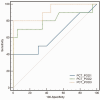Procalcitonin and C-reactive protein as early predictors in patients at high risk of colorectal anastomotic leakage
- PMID: 38867514
- PMCID: PMC11179477
- DOI: 10.1177/03000605241258160
Procalcitonin and C-reactive protein as early predictors in patients at high risk of colorectal anastomotic leakage
Abstract
Objective: To assess the diagnostic value of C-reactive protein (CRP) and procalcitonin (PCT) for anastomotic leakage (AL) following colorectal surgery.
Methods: We retrospectively analyzed data for patients who underwent colorectal surgery at our hospital between November 2019 and December 2023. CRP and PCT were measured postoperatively to compare patients with/without AL, and changes were compared between low- and high-risk groups. Receiver operating characteristic (ROC) curve analysis was used to assess the diagnostic accuracy of CRP and PCT to identify AL in high-risk patients.
Results: Mean CRP was 142.53 mg/L and 189.57 mg/L in the low- and high-risk groups, respectively, on postoperative day (POD)3. On POD2, mean PCT was 2.75 ng/mL and 8.16 ng/mL in low- and high-risk patients, respectively; values on POD3 were 3.53 ng/mL and 14.86 ng/mL, respectively. The areas under the curve (AUC) for CRP and PCT on POD3 were 0.71 and 0.78, respectively (CRP cut-off: 235.64 mg/L; sensitivity: 96%; specificity: 89.42% vs PCT cut-off: 3.94 ng/mL; sensitivity: 86%; specificity: 93.56%; AUC: 0.78). The AUC, sensitivity, and specificity for the combined diagnostic ability of CRP and PCT on POD3 were 0.92, 90%, and 100%, respectively (cut-off: 0.44).
Conclusions: Combining PCT and CRP on POD3 enhances the diagnostic accuracy for AL.
Keywords: C-reactive protein; Procalcitonin; anastomotic leakage; colon leakage score; diagnostic accuracy; postoperative; sensitivity; specificity.
Conflict of interest statement
Declaration of conflicting interestThe authors declare that there is no conflict of interest.
Figures






Similar articles
-
Anastomotic leakage after elective colorectal surgery: a prospective multicentre observational study on use of the Dutch leakage score, serum procalcitonin and serum C-reactive protein for diagnosis.BJS Open. 2020 Jun;4(3):499-507. doi: 10.1002/bjs5.50269. Epub 2020 Mar 5. BJS Open. 2020. PMID: 32134216 Free PMC article.
-
Procalcitonin and C-reactive protein as early markers of anastomotic leak after laparoscopic colorectal surgery within an enhanced recovery after surgery (ERAS) program.Surg Endosc. 2018 Sep;32(9):4003-4010. doi: 10.1007/s00464-018-6144-x. Epub 2018 Mar 8. Surg Endosc. 2018. PMID: 29520440
-
C-reactive Protein and Procalcitonin Levels to Predict Anastomotic Leak After Colorectal Surgery: Systematic Review and Meta-analysis.J Gastrointest Surg. 2023 Jan;27(1):166-179. doi: 10.1007/s11605-022-05473-z. Epub 2022 Sep 29. J Gastrointest Surg. 2023. PMID: 36175720
-
Diagnostic accuracy of C-reactive protein and procalcitonin in the early diagnosis of infections after laparoscopic rectal cancer surgery.ANZ J Surg. 2022 Oct;92(10):2600-2606. doi: 10.1111/ans.17895. Epub 2022 Jul 11. ANZ J Surg. 2022. PMID: 35818676
-
Diagnostic accuracy of procalcitonin for the early diagnosis of anastomotic leakage after colorectal surgery: a meta-analysis.ANZ J Surg. 2020 May;90(5):675-680. doi: 10.1111/ans.15291. Epub 2019 Jun 23. ANZ J Surg. 2020. PMID: 31230412
Cited by
-
Cost Saving Analysis of an Enhanced Recovery After Surgery (ERAS) Program for Elective Colorectal Surgery in an ERAS Qualified and Training Center.World J Surg. 2025 Apr;49(4):850-858. doi: 10.1002/wjs.12548. Epub 2025 Mar 8. World J Surg. 2025. PMID: 40056394 Free PMC article.
-
Procalcitonin as an Early Marker of Colorectal Anastomotic Leakage in Postoperative Colorectal Cancer Patients: A Systematic Review and Meta-Analysis.Cureus. 2024 Oct 1;16(10):e70647. doi: 10.7759/cureus.70647. eCollection 2024 Oct. Cureus. 2024. PMID: 39483587 Free PMC article. Review.
-
Predictive Biomarkers for the Early Detection of Anastomotic Leaks in Colorectal Surgeries: A Systematic Review.Cureus. 2024 Nov 27;16(11):e74616. doi: 10.7759/cureus.74616. eCollection 2024 Nov. Cureus. 2024. PMID: 39735081 Free PMC article. Review.
-
Globotriaosylceramide as a potential biomarker for auxiliary detection of lower respiratory tract infections of Pseudomonas aeruginosa.Exp Ther Med. 2025 Feb 24;29(4):83. doi: 10.3892/etm.2025.12833. eCollection 2025 Apr. Exp Ther Med. 2025. PMID: 40084191 Free PMC article.
-
Visceral to subcutaneous fat area ratio predicts early postoperative small bowel obstruction after total gastrectomy for cardia cancer.J Int Med Res. 2024 Oct;52(10):3000605241282077. doi: 10.1177/03000605241282077. J Int Med Res. 2024. PMID: 39394877 Free PMC article.
References
-
- Foppa C, Ng SC, Montorsi M, et al.. Anastomotic leak in colorectal cancer patients: new insights and perspectives. Eur J Surg Oncol 2020; 46: 943–954. - PubMed
-
- Stearns AT, Liccardo F, Tan KN, et al.. Physiological changes after colorectal surgery suggest that anastomotic leakage is an early event: a retrospective cohort study. Colorectal Dis 2019; 21: 297–306. - PubMed
-
- McDermott FD, Heeney A, Kelly ME, et al.. Systematic review of preoperative, intraoperative and postoperative risk factors for colorectal anastomotic leaks. Br J Surg 2015; 102: 462–479. - PubMed
-
- Komen N, De Bruin RW, Kleinrensink GJ, et al.. Anastomotic leakage, the search for a reliable biomarker. A review of the literature. Colorectal Dis 2008; 10: 109–115. - PubMed
MeSH terms
Substances
LinkOut - more resources
Full Text Sources
Research Materials
Miscellaneous

